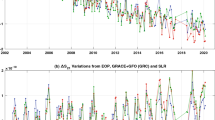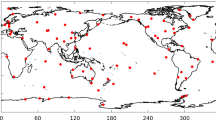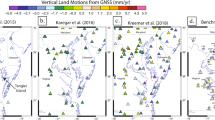Abstract
GNSS observations provided by the global tracking network of the International GNSS Service (IGS, Dow et al. in J Geod 83(3):191–198, 2009) play an important role in the realization of a unique terrestrial reference frame that is accurate enough to allow a detailed monitoring of the Earth’s system. Combining these ground-based data with GPS observations tracked by high-quality dual-frequency receivers on-board low earth orbiters (LEOs) is a promising way to further improve the realization of the terrestrial reference frame and the estimation of geocenter coordinates, GPS satellite orbits and Earth rotation parameters. To assess the scope of the improvement on the geocenter coordinates, we processed a network of 53 globally distributed and stable IGS stations together with four LEOs (GRACE-A, GRACE-B, OSTM/Jason-2 and GOCE) over a time interval of 3 years (2010–2012). To ensure fully consistent solutions, the zero-difference phase observations of the ground stations and LEOs were processed in a common least-squares adjustment, estimating all the relevant parameters such as GPS and LEO orbits, station coordinates, Earth rotation parameters and geocenter motion. We present the significant impact of the individual LEO and a combination of all four LEOs on the geocenter coordinates. The formal errors are reduced by around 20% due to the inclusion of one LEO into the ground-only solution, while in a solution with four LEOs LEO-specific characteristics are significantly reduced. We compare the derived geocenter coordinates w.r.t. LAGEOS results and external solutions based on GPS and SLR data. We found good agreement in the amplitudes of all components; however, the phases in x- and z-direction do not agree well.












Similar content being viewed by others
Notes
An averaged SLR station distribution of 60, 65 and 70% for the +x, +y and +z hemisphere is present in the weekly ILRS solution between 2010.0 and 2013.0.
http://ggosatm.hg.tuwien.ac.at/, Dec.2015.
References
Altamimi Z, Collilieux X, Métivier L (2011) ITRF2008: an improved solution of the international terrestrial reference frame. J Geod 85(8):457–473. doi:10.1007/s00190-011-0444-4
Arnold D, Meindl M, Beutler G, Dach R, Schaer S, Lutz S, Prange L, Sośnica K, Mervart L, Jäggi A (2015) Code’s new solar radiation pressure model for gnss orbit determination. J Geod 89(8):775–791. doi:10.1007/s00190-015-0814-4
Bettadpur S (2012) Product specification document, 4.6 (edn). ftp://podaac.jpl.nasa.gov/allData/grace/docs/ProdSpecDoc_v4.6.pdf
Blewitt G, Lavallée D, Clarke P, Nurutdinov K (2001) A new global mode of earth deformation: seasonal cycle detected. Science 294(5550):2342–2345. doi:10.1126/science.1065328
Bock H, Jäggi A, Beutler G, Meyer U (2014) GOCE: precise orbit determination for the entire mission. J Geod 88(11):1047–1060. doi:10.1007/s00190-014-0742-8
Bock H, Jäggi A, Meyer U, Dach R, Beutler G (2011) Impact of GPS antenna phase center variations on precise orbits of the GOCE satellite. Adv Space Res 47(11):1885–1893. doi:10.1016/j.asr.2011.01.017
Böhm J, Werl B, Schuh H (2006) Troposphere mapping functions for GPS and VLBI from European Centre for medium-range weather forecasts operational analysis data. J Geophy Res 111(B2):B02406. doi:10.1029/2005JB003629
Brockmann E (1997) Combination of solutions for geodetic and geodynamical applications of the Global Positioning System (GPS). Geodätisch-geophysikalische Arbeiten in der Schweiz. Schweizerische Geodätische Kommission
Cerri L, Berthias JP, Bertiger WI, Haines BJ, Lemoine FG, Mercier F, Reis JC, Willis P, Zelensky NP, Ziebart M (2010) Precise orbit determination standards for the Jason series of altimeter missions. Mar Geod 33:379–418. doi:10.1080/01499419.2010.488966
Cerri L, Ferrage P (2015) DORIS satellites models implemented in POE processing. ftp://ftp.ids-doris.org/pub/ids/satellites/DORISSatelliteModels.pdf
Chen G, Herring T (1997) Effects of atmospheric azimuthal asymmetry on the analysis of space geodetic data. J Geophy Res 102(B9):20489–20502. doi:10.1029/97JB01739
Cheng M, Ries J, Tapley B (2013) Geocenter variations from analysis of SLR data. In: Altamimi Z, Collilieux X, (eds) Reference frames for applications in geosciences, volume 138 of IAG Symposia, pp 19–25. Springer, Berlin. doi:10.1007/978-3-642-32998-2_4
Dach R, Brockmann E, Schaer S, Beutler G, Meindl M, Prange L, Bock H, Jäggi A (2009) GNSS processing at CODE: status report. J Geod 83(3–4):353–366. doi:10.1007/s00190-008-0281-2
Dach R, Lutz S, Walser P, Fridez P (2015) Bernese GNSS Software Version 5.2. doi:10.7892/boris.72297
Dong D, Yunck T, Heflin M (2003) Origin of the international terrestrial reference frame. J Geophys Res. doi:10.1029/2002JB002035
Dow JM, Neilan RE, Rizos C (2009) The International GNSS service in a changing landscape of global navigation satellite systems. J Geod 83(3):191–198. doi:10.1007/s00190-008-0300-3
Eanes R, Kar S, Bettadapur S, Watkins M (1997) Low-frequency geocenter motion determined from SLR tracking. Eos Trans AGU 78:46
Floberghagen R, Fehringer M, Lamarre D, Muzi D, Frommknecht B, Steiger C, Piñeiro J, Da Costa A (2011) Mission design, operation and exploitation of the gravity field and steady-state ocean circulation explorer mission. J Geod 85(11):749–758. doi:10.1007/s00190-011-0498-3
Flohrer C, Otten M, Springer T, Dow J (2011) Generating precise and homogeneous orbits for Jason-1 and Jason-2. Adv Space Res 48:152–172. doi:10.1016/j.asr.2011.02.017
Förste C, Flechtner F, Schmidt R, Stubenvoll R, Rothacher M, Kusche J, Neumayer H, Biancale R, Lemoine J, Barthelmes F et al (2008) EIGEN-GL05C-A new global combined high-resolution GRACE-based gravity field model of the GFZ-GRGS cooperation. Geophys Res Abstr 10:EGU2008-A
Fritsche M, Dietrich R, Knöfel C, Rülke A, Vey S, Rothacher M, Steigenberger P (2005) Impact of higher-order ionospheric terms on GPS estimates. Geophy Res Lett. doi:10.1029/2005GL024342
Fritsche M, Dietrich R, Rülke A, Rothacher M, Steigenberger P (2010) Low-degree earth deformation from reprocessed GPS observations. GPS solut 14(2):165–175. doi:10.1007/s10291-009-0130-7
Fritsche M, Sośnica K, Rodríguez-Solano CJ, Steigenberger P, Wang K, Dietrich R, Dach R, Hugentobler U, Rothacher M (2014) Homogeneous reprocessing of GPS, GLONASS and SLR observations. J Geod 88(7):625–642. doi:10.1007/s00190-014-0710-3
Garcia M, Montenbruck O (2007) TerraSAR-X/TanDEM-X GPS Antenna Phase Center Analysis and Results. Space Flight Technology, German Space Operations Center, TN 07-03
Haines BJ, Bar-Sever YE, Bertiger WI, Desai SD, Harvey N, Sibois AE, Weiss JP (2015) Realizing a terrestrial reference frame using the global positioning system. Geophys Res Lett. doi:10.1002/2015JB012225
Hugentobler U, Jäggi A, Schaer S, Beutler G (2005) Combined processing of GPS data from ground station and LEO receivers in a global solution. In: Sansó F (ed) A window on the future of Geodesy. Springer, Berlin, pp 169–174. doi:10.1007/3-540-27432-4_30
Jäggi A, Hugentobler U, Beutler G (2006) Pseudo-stochastic orbit modeling techniques for low-Earth orbiters. J Geod 80(1):47–60
Kang Z, Tapley B, Chen J, Ries J, Bettadpur S (2009) Geocenter variations derived from GPS tracking of the GRACE satellites. J Geod 83(10):895–901. doi:10.1007/s00190-009-0307-4
König R, Dahle C, Vei M, Neumayer K-H (2015) A geocenter time series from a combination of LAGEOS and GRACE observations. IAG Symposia, pp 1–6. Springer, Berlin. doi:10.1007/1345_2015_24
Kuang D, Bar-Sever Y, Haines B (2015) Analysis of orbital configurations for geocenter determination with GPS and low-Earth orbiters. J Geod 89(5):471–481. doi:10.1007/s00190-015-0792-6
Lambin J, Morrow R, Fu L-L, Willis JK, Bonekamp H, Lillibridge J, Perbos J, Zaouche G, Vaze P, Bannoura W et al (2010) The OSTM/Jason-2 mission. Mar Geod 33(S1):4–25. doi:10.1080/01490419.2010.491030
Lavallée DA, Dam TV, Blewitt G, Clarke PJ (2006) Geocenter motions from GPS: a unified observation model. Geophy Res Lett 111(B5):B05405. doi:10.1029/2005JB003784
Lyard F, Lefevre F, Letellier T, Francis O (2006) Modelling the global ocean tides: modern insights from FES2004. Ocean Dyn 56(5–6):394–415. doi:10.1007/s10236-006-0086-x
Meindl M, Beutler G, Thaller D, Dach R, Jäggi A (2013) Geocenter coordinates estimated from GNSS data as viewed by perturbation theory. Adv Space Res 51:1047–1064. doi:10.1016/j.asr.2012.10.026
Montenbruck O, Kroes R (2003) In-flight performance analysis of the CHAMP BlackJack receiver. GPS Solut 7:74–86. doi:10.1007/S10291-003-0055-5
Pavlis E (1999) Fortnightly resolution geocenter series: a combined analysis of Lageos 1 and 2 SLR data. IERS Tech Note 25:75–84
Petit G, Luzum B (2010) IERS Conventions (2010). IERS Tech Note 36. Verlag des Bundesamts fr Kartographie und Geodäsie, Frankfurt am Main. ISBN 3-89888-989-6
Ray R, Ponte R (2003) Barometric tides from ECMWF operational analyses. Ann Geophys 21(8):1897–1910
Rebischung P, Garayt B (2013) Recent results from the igs terrestrial frame combinations. In: Altamimi Z, Collilieux X, (eds) Reference frames for applications in geosciences, volume 138 of IAG Symposia, pp 69–74. Springer, Berlin. doi:10.1007/978-3-642-32998-2_12
Rietbroek R, Fritsche M, Brunnabend S-E, Daras I, Kusche J, Schröter J, Flechtner F, Dietrich R (2012) Global surface mass from a new combination of GRACE, modelled OBP and reprocessed GPS data. J Geodyn 59–60:64–71. doi:10.1016/j.jog.2011.02.003
Rodríguez-Solano CJ (2014) Impact of non-conservative force modeling on GNSS satellite orbits and global solutions. Dissertation, Technische Universität München, München
Roggenbuck O, Thaller D, Engelhardt G, Franke S, Dach R, Steigenberger P (2015) Loading-induced deformation due to atmosphere, ocean and hydrology: model comparisons and the impact on global SLR, VLBI and GNSS solutions, pp 1–7. Springer, Berlin. doi:10.1007/1345_2015_214
Schmid R, Dach R, Collilieux X, Jäggi A, Schmitz M, Dilssner F (2016) Absolute IGS antenna phase center model igs08.atx: status and potential improvements. J Geod 90(4):343–364. doi:10.1007/s00190-015-0876-3
Sośnica K (2015) Determination of precise satellite orbits and geodetic parameters using satellite laser ranging. Geodätisch-geophysikalische Arbeiten in der Schweiz. Schweizerische Geodätische Kommission. http://boris.unibe.ch/53915/
Sośnica K, Jäggi A, Meyer U, Thaller D, Beutler G, Arnold D, Dach R (2015) Time variable Earth’s gravity field from SLR satellites. J Geod. doi:10.1007/s00190-015-0825-1
Springer T, Beutler G, Rothacher M (1999) A new solar radiation pressure model for GPS satellites. GPS Solut 2(3):50–62. doi:10.1007/PL00012757
Tapley BD, Bettadpur S, Ries JC, Thompson PF, Watkins MM (2004) GRACE measurements of mass variability in the Earth system. Science 305(5683):503–505
Thaller D, Sośnica K, Dach R, Jäggi A, Beutler G, Mareyen M, Richter B (2014) Geocenter coordinates from GNSS and combined GNSS-SLR solutions using satellite co-locations. In: Earth on the edge: science for a sustainable planet, pp 129–134. Springer, Berlin. doi:10.1007/978-3-642-37222-3_16
Vigue Y, Lichten SM, Blewitt G, Heflin MB, Malla RP (1992) Precise determination of Earth’s center of mass using measurements from the global positioning system. Geophys Res Let 19(14):1487–1490
Williams H (2015) Validating the 1-cm orbit. Master’s thesis, University of Texas, Austin
Wu X, Heflin MB, Ivins ER, Fukumori I (2006) Seasonal and interannual global surface mass variations from multisatellite geodetic data. J Geophys Res. doi:10.1029/2005JB004100
Wu X, Ray J, van Dam T (2012) Geocenter motion and its geodetic and geophysical implications. J Geodyn 58:44–61. doi:10.1016/j.jog.2012.01.007
Acknowledgements
The authors want to thank IGS, ILRS, CODE, TU Vienna and the satellite missions GOCE, GRACE and OSTM/Jason-2 for providing the necessary observations and products. We would also like to thank three anonymous reviewers for their assistance in evaluating this paper and their helpful recommendations. This work was done within the projects SNF 200021E-160421 (funded by Swiss National Science Foundation) and “Co-location of Space Geodetic Techniques on Ground and in Space” which is part of the Deutsche Forschungsgemeinschaft funded research unit on reference systems (DFG FOR 1503).
Author information
Authors and Affiliations
Corresponding author
Rights and permissions
About this article
Cite this article
Männel, B., Rothacher, M. Geocenter variations derived from a combined processing of LEO- and ground-based GPS observations. J Geod 91, 933–944 (2017). https://doi.org/10.1007/s00190-017-0997-y
Received:
Accepted:
Published:
Issue Date:
DOI: https://doi.org/10.1007/s00190-017-0997-y




